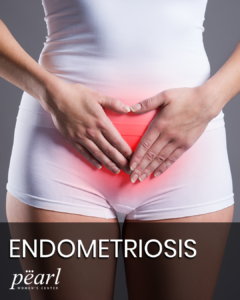
If you have excessive menstrual bleeding and more painful periods, bowel movements, and intercourse, you may have endometriosis. Our gynecologic surgeons and providers offer evaluation and various recommended treatments for patients with endometriosis in Portland, Oregon.
To find out more about endometriosis and your treatment options, contact Pearl Women’s Center. Ask a question, book online, or call our office in Portland at (503) 771-1883. We serve patients from Oregon, Washington, Idaho, Northern California, and Alaska.
Endometriosis is a condition in which the type of cells that normally line the inside of the uterus invade other structures in the pelvis, such as the ovaries, the tubes, the bladder and even the intestines. Up to 15% of women of childbearing age and 30% of women with infertility are found to have Endometriosis. It is a hormonally driven disease. When a woman with endometriosis has her menstrual cycle, not only does she have bleeding from the lining of her uterus, but also from the lesions inside her body. This may cause severe pain, scarring and infertility. Sometimes the condition may be so invasive that it blocks off part of the intestines making even bowel movements very painful.
Signs include cyclic pelvic pain, painful periods, painful bowel movements, pain with intercourse, infertility and abnormal bleeding, however a true diagnosis must be made with a surgical procedure, such as laparoscopy, to look inside the pelvis to assess and biopsy the tissue.
We do not completely know what causes endometriosis. What we do know is that it can run in families, so there may be a genetic predisposition. We also suspect that it is associated with inflammation and immune dysfunction, but the exact cause has not yet been identified.
If you think you have endometriosis, the first step is to talk with your doctor about your pain. Your doctor should do a very thorough exam and pelvic ultrasound to help identify exact sources of pain. Sometimes a pelvic MRI is useful if there are symptoms in the colon or rectum.
Because endometriosis is a hormonally related disease, birth control pills may be helpful in treating both pain and associated abnormal bleeding. An IUD that contains a progestin called levonorgestrel can also be helpful for the same reason. Sometimes an injection of a medicine that causes a temporary state of menopause, shutting down the normal production of estrogen and progesterone, will help relieve the pain. However, this works temporarily to help with pain and does not actually cure the underlying condition.
The most effective treatment for endometriosis seems to be surgically removing, “excising,” all of the disease. This can be done by laparoscopy, a surgery where tiny incisions on the abdomen are used to place a camera and instruments. In severe cases, or in women who have completed childbearing, a hysterectomy may be the best option, but usually only if all other options have been tried. Ideally, excision of endometriosis should be done by an expert surgeon who is fellowship trained in minimally invasive gynecology as often the lesions of endometriosis are deeply invasive and require special expertise for removal.
Some researchers believe that diet and lifestyle may play a role in the link between pelvic pain and endometriosis. For example, an Italian study published in 2015 demonstrated a decrease in pelvic pain in patients who eliminated wheat products and gluten from their diet. A recent Polish study showed that patients with a diet rich in fresh fruits, vegetables, Omega 3 Fatty acids (Fish Oils) had a lower risk of developing endometriosis whereas consumption of fats, red meat and alcohol increased the risk. Supplements and lifestyle modifications may be helpful in managing pain but have not been shown to cure the disease.